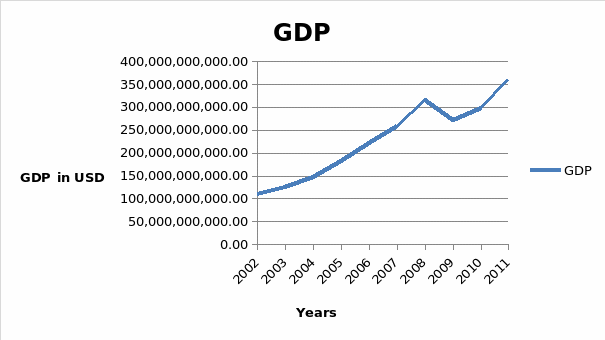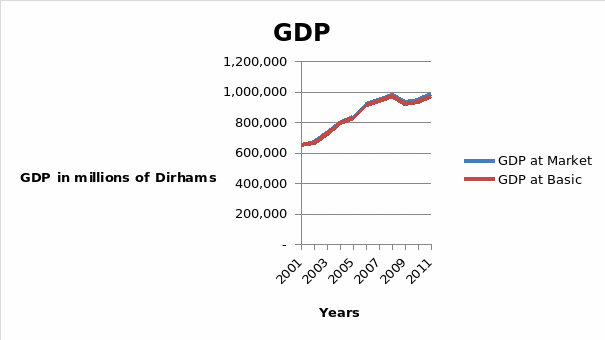Introduction
About GDP
Gross Domestic Product (GDP) is a useful indicator of the status of the economy of a country. GDP measures the total value of goods and services produced in a country within a given period. This is commonly measured either monthly, quarterly, semi-annually, or annually. Measuring GDP is a challenge for an economist in all countries. This is because it is often difficult to quantify all economic activities in the country. This hinders their inclusion (Parkin, 2007).
Approaches to measuring GDP
There are three approaches that economists use to estimate the value of GDP in a country. These approaches are income approach, expenditure approach and value-added approach. The income approach measures GDP by adding up payment to employees, gross profits for businesses and net taxes. This approach is not commonly used since it is difficult to obtain income estimates of activities in the black market. Expenditure approach captures all expenses in the economy. The expenses are grouped into four.
The value-added approach measures GDP by adding together valued-added during production. This approach is not commonly used because it is difficult to accurately obtain the amount of value-added during production. Out of the three approaches, the commonly used approach is the expenditure approach since the values of the components are easy to find. The three approaches give the same value of GDP (Parkin, 2007).
Aim of the paper
This paper analyses the GDP of the United Arab Emirates. It looks at the components of GDP when using the expenditure approach. Finally, it computes the weights of each component of GDP.
A national account of United Arab Emirates
Background of the UAE
United Arab Emirates (UAE) borders Oman and Saudi Arabia. It is an Arab country. Abu Dhabi, Ajman, Dubai, Fujairah, Ras al-Khaimah, Sharjah, and Umm al-Quwain are the seven federations which make up UAE. Census conducted in 2010 showed that the country had a total population of 8,264,070. The country’s capital is Abu Dhabi, with about 10% of the population.
The country’s economy heavily relies on the export of petroleum and natural gas. UAE also exports metal such as aluminum, steel, iron, and textile. More than 85% of the country’s income originates from the export of gas and petroleum. Besides, UAE is the seventh-largest producer of petroleum and gas in the world (United Arab Emirates National Bureau of Statistics, 2012).
GDP of the UAE
GDP of the UAE has been on an upward trend over the past ten years from 2002.
Table 1.0 GDP of UAE in US dollars in current prices
Continuation of table 1.0
The graph below shows the trend of GDP for the past 10 years.

From the above graph, we can deduce that the UAE had an upward trend in GDP over the 10 years. However, there was a decline in 2009.
National account values for countries are often reported in US dollars. This allows for comparability of economic results. For this analysis, the values are quoted in a home currency that is, Dirham. Further, the values are quoted at constant prices with 2007 as the base year. The table below shows the GDP of the UAE for the past 10 years in Dirham.
Table 1.1 GDP of UAE in millions of Dirhams
Continuation of table 1.1
The graph below shows the trend of GDP both at market and basic rate for United Arab Emirates from 2002 to 2011.

The graph above depicts the same trend as the one shown in the earlier graph. The graph shows an upward trend in GDP for both market and basic prices.
Rate of real GDP growth
The table below shows the rate of growth of real GDP from 2002 to 2011. These rates are arrived at after removing the effect of inflation.
Table 1.2 Rate of real GDP growth
Continuation of table 1.2
From the above comparisons of GDP, we can deduce that both real and nominal values of GDP yield the same trend. Similarly, GDP in US dollars and Dirham yielded similar trend.
Components of GDP for 2011 and 2010
The expenditure approach is used to break down the various components of GDP for UAE. These components are consumer expenditure, government spending, investment, and net imports (exports fewer imports). The table below summarizes components of GDP for UAE for 2011 and 2010.
Table 1.3 components of GDP for UAE
From the table above, it is clear that GDP grew from AED942, 397 to AED981, 659 million. This is equivalent to a 4.17% increase. All the other components of GDP also grew from 2010 to 2011 apart from net exports. For instance, consumption expenditure grew from AED494, 004 to AED515, 398. This equals to 4.33% growth. Government expenditure increased from AED78, 383 to AED80, 732. This amounts to 3.0% growth. Investment grew from AED260, 257 to AED289, 177. This is equivalent to an 11.11% increase. Finally, net exports declined from AED109, 753 to AED96, 659. This is equivalent to 12.21% decline.
Weight of various components of GDP
Division of the various components by the GDP gives their weight. Table 1.4 below shows a summary of the computations of the weights. From the results, consumption expenditure occupies a larger proportion of GDP than the other components. In 2010, consumption expenditure occupied 52.42% and 52.50% in 2011. Government expenditure occupied 8.31% in 2010 and 8.22% in 2011. Investment expenditure occupied 27.62% in 2010 and 29.46% in 2011. Finally, Net exports occupied 11.65% in 2010 and 9.82% in 2011. In terms of weights, consumption expenditure takes the largest proportion of GDP. Investment expenditure falls in the second position. The table below shows the ranks of the four components. They are ranked according to their weights.
Table 1.4 Weight of various components of
GDP arranged in ascending order
From the above table, consumption takes the largest proportion of GDP. This is common practice with almost economies. In most countries, consumption expenditure by households occupies a large proportion of GDP. In the table above, investment expenditure follows consumption expenditure, then net exports and government expenditure (Mankiw, 2011).
Captioned data
In the data provided, captions appear in the data for 2010 and 2011. Results for 2010 are marked as preliminary and those of 2011 are estimates. Preliminary results imply that they are preceding and leading up to the main results. Therefore, there may be minor deviations of final results from the preliminary results. 2012 results are all estimates. In most cases, these estimates arise from the trend that develops over a long period like 10 years. In addition, the mathematical relationship of variables in the economy and anticipated economic behavior in a given period provide the estimates the national account values.
Therefore, there is always a minimal deviation of the estimated values from the actual. This is because all movement in the economy often taken into account when coming up with the estimates. To be on the right track, the government of UAE needs to confirm the economic data for 2011. In addition, they need to provide actual data for 2011. There may be a slight variation of these variables depending on the adjustments done on the values (Bade & Parkin, 2009).
Conclusion
GDP is a basic tool for assessing the health of an economy. The trend of GDP over a period gives a good indication of the state of the economy. Observing movements of various components of GDP is necessary. This is because they show areas which impact heavily on GDP. The results above show that the GDP of UAE as increased over the years. It further shows that consumption makes a greater proportion of GDP. Finally, it is necessary to take into consideration of captions in a given data when carrying out analysis.
References
Bade, R. & Parkin, M. (2009). Essential Foundations of Economics. United States: Pearson Education
Mankiw, G. (2011). Principles of Economics. USA: Cengage Learning.
Parkin, M. (2007). Economics. United States: Pearson Addison-Wesley.
United Arab Emirates National Bureau of Statistics, (2012). Economic Statistics.